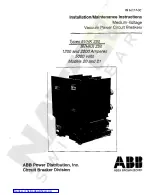
ABB | SACE Emax 2
Electronic accessories | 13 - Other accessories
223 | © 2013
ABB |
1SDH001000R0002 - L7804
Ekip Signalling 10K modules
The Ekip Signalling 10K is an external signalling accessory module that can be installed on a
DIN rail.
It can be installed in the presence of Ekip Dip, Touch, Hi-Touch, G Touch, and G Hi-Touch
releases. It must be powered independently from the releases to which it is connected, and can
be powered in AC at nominal 110...240 V AC, or in DC at nominal 24...48 V DC.
On the front it has:
• Ten contacts for output signals.
• Ten or eleven digital inputs.
• A power status LED, and twenty or twenty-one signalling LEDs (one for each output/input).
It can communicate with the outside in two alternative modes:
• Via Local Bus, with a single release equipped with an Ekip Supply module (see page 162).
• Via Ethernet, with a maximum of four releases, each equipped with an Ekip Link module
(see page 213).
With communication via Local Bus, unless the release is disconnected, the closing/opening
of the contacts of the module is commanded by the release, and the information on the state
of the inputs is transmitted by the module to the release. In particular, the release can be
programmed so that:
• The closing/opening of a contact corresponds to a desired event or combination of events
detected by the release.
• The activation of an input corresponds to an action on the part of the release.
With multiple 10-K modules connected via Local Bus to the same release, there can be at
most three of these, and they must be configured differently as one 10K-1, one 10K-2 and
one 10K-3.
With Ethernet communication:
• The module is connected to a network on which the releases equipped with an Ekip Link
module share data packets containing information on their state.
• The IP Addresses of the releases to which you wish to connect it must be inserted on the
module, and each contact can be programmed so as to be closed/open in correspondence
to an event or combination of events regarding a connected release.
• If the module receives a packet sent by a connected release, the module reads the contents
of the packet, and initiates any programmed action.









































